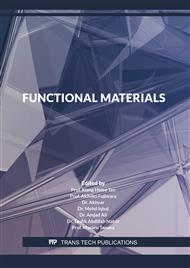p.99
p.107
p.113
p.121
p.131
p.139
p.147
p.153
p.159
Producing Ceria (CeO2) Nanoparticles Using Ethanol/Water Mixture as Solvent: Effect of Temperature on the Morphology and Crystallite Size
Abstract:
Cerium oxide has been widely used in many application. One of the most important applications is for chemical mechanical application/planarization (CMP). In the current work, ceria nanoparticles have been prepared via precipitation method using ethanol/water mixture as the solvent, while cerium nitrate hexahydrate as cerium source and ammonium solution as precipitant. The effects of two different temperatures (i.e. 30 and 50°C) and two different apparatus setup (i.e. Setup A and Setup B) on the morphology and crystallite size of the ceria nanoparticles were studied. The morphology and crystallite size of the ceria were analyzed using X-Ray Diffractometer (XRD) and Tranmission Electron Microscopy (TEM). The XRD analysis results showed that the peak intensity of the ceria nanoparticles prepared by using setup B was much higher than the ones prepared by using Setup A. The XRD results revealed that the crystallinity growth and mean crystallite size of the ceria was better or higher when using Setup B. The crystallite size of the calcined ceria nanoparticles were found to be 9.8; 10.5; 14.5 nm for Ceria-1, Ceria-2, and Ceria-3 samples, respectively. In addition, the TEM images showed that Ceria-3 sample exhibited better morphology and less agglomerated compared to that of Ceria-1 and Ceria-2 samples. Futhermore, Ceria-3 sample also had better dispersion stability compared to that of Ceria-1 and Ceria-2 samples due to its better morphology.
Info:
Periodical:
Pages:
131-137
Citation:
Online since:
August 2022
Keywords:
Price:
Сopyright:
© 2022 Trans Tech Publications Ltd. All Rights Reserved
Share:
Citation:



